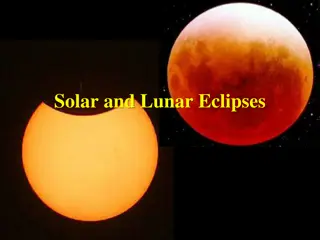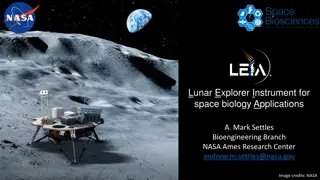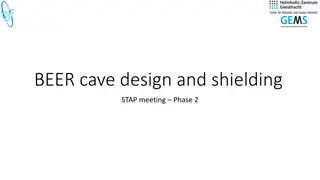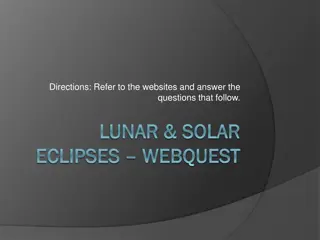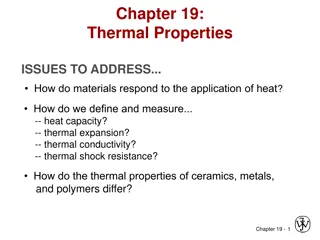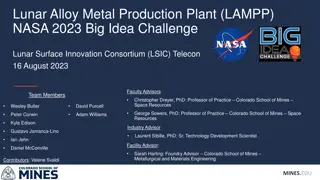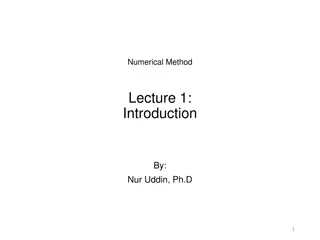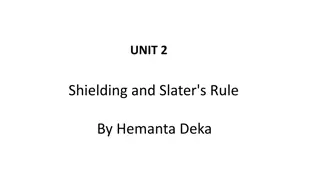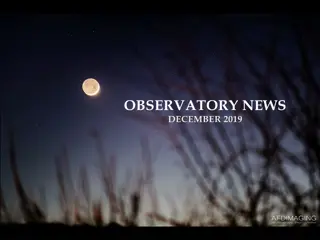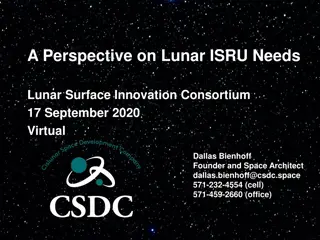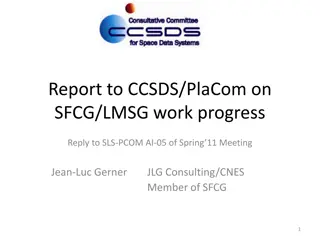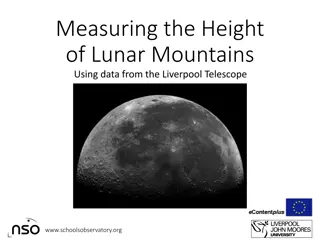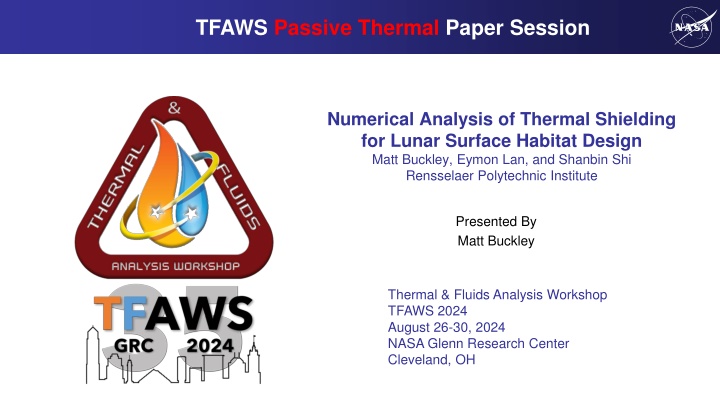
Numerical Analysis of Thermal Shielding for Lunar Habitat Design
Designing a lunar habitat requires innovative solutions due to extreme temperature fluctuations. This study focuses on conducting transient thermal analysis to optimize regolith wall thickness and energy requirements for sustaining habitable conditions. The technical approach involves developing a MATLAB code for heat transfer analysis through a regolith wall and modifying assumptions to enhance accuracy.
Download Presentation

Please find below an Image/Link to download the presentation.
The content on the website is provided AS IS for your information and personal use only. It may not be sold, licensed, or shared on other websites without obtaining consent from the author. If you encounter any issues during the download, it is possible that the publisher has removed the file from their server.
You are allowed to download the files provided on this website for personal or commercial use, subject to the condition that they are used lawfully. All files are the property of their respective owners.
The content on the website is provided AS IS for your information and personal use only. It may not be sold, licensed, or shared on other websites without obtaining consent from the author.
E N D
Presentation Transcript
TFAWS Passive Thermal Paper Session Numerical Analysis of Thermal Shielding for Lunar Surface Habitat Design Matt Buckley, Eymon Lan, and Shanbin Shi Rensselaer Polytechnic Institute Presented By Matt Buckley Thermal & Fluids Analysis Workshop TFAWS 2024 August 26-30, 2024 NASA Glenn Research Center Cleveland, OH
Contents Background Research objective Technical approach Problem description Mathematical models Numerical implementation Results Conclusions Future work TFAWS 2024 August 26-30, 2024 2
Background Motivation Pursuing long-duration human presence on the Moon is paramount for advancing scientific exploration In-situ resource utilization is critical to minimize launch mass from Earth Harsh lunar environments including extreme temperatures fluctuations from about -133 to 120 necessitating innovative solutions for habitat construction Lunar regolith found to be an excellent insulator Numerical challenges Transient thermal analysis is a challenge due to lunar temperature fluctuations and lengthy day cycles Low thermal diffusivity of lunar regolith Lumped assumption of conducting material not appropriate since Bi >> 0.1 TFAWS 2024 August 26-30, 2024 3
Research Objectives Develop a model to conduct transient thermal analysis of prototypical habitat utilizing in-situ resources Approximate the transient heat transfer and find the internal temperature change Determine optimal regolith wall thickness for lunar habitat construction Estimate energy requirements for maintaining habitable conditions within prototypical lunar habitat TFAWS 2024 August 26-30, 2024 4
Technical Approach Conduct literature review on lunar surface conditions and long duration space travel Develop an in house MATLAB code for numerical analysis of heat transfer through a regolith wall Conduct transient thermal analysis to account for lunar surface temperature variations across multiple lunar day cycles with a simplified model Modify assumptions to make the analysis more accurate Optimize the wall thickness based on quasi-steady heating requirements TFAWS 2024 August 26-30, 2024 5
Problem Description Long lunar day cycles and large surface temperature fluctuations make transient heat transfer analysis difficult. Thermal requirements for a prototypical lunar habitat need to consider environmental heat transfer Solar radiation Radiation to vacuum of space ?? ? ? ? ? ? [kg/m3] 1,800 1.18 [W/m K] 0.01 0.02597 [1/K] - 0.00367 [Pa s] - 1.8e-5 [m2/s] 6.6e-9 2.2e-5 [J/kg K] 840 1006 Wadis Air R. Balasubramaniam et al., Analysis of Solar-Heated Thermal Wadis to Support Extended-Duration Lunar Exploration, Proceedings of 47th AIAA Aerospace Sciences Meeting, January 5-8, 2009, Orlando, Florida, USA. TFAWS 2024 August 26-30, 2024 6
Assumptions 1D heat transfer No heat generation Consider only incoming solar radiation and radiation out to vacuum of space Internal natural convection Internal environment treated as lumped Constant material properties TFAWS 2024 August 26-30, 2024 7
Mathematical Models 2 1 3 4 Solar radiation flux = = Natural convection Conduction Radiation T T t abs s space sin 2 , day q air T T " solar rad q ,max t , w in , w out , c 0, night 0.87 abs [1] Externalwallnode T c x t = W = 1450m 2,542,752 q T x ,max = s 2 s = " radiation q k p t c " radiation q " solar rad q + " emission q , ( ) n n T T 1 n n T T , 1 w out N , , w out w out = Solar radiation heat flux " radiation q c x k Radiation heat transfer to vacuum of space p / 2 t x ) ( = " emission q 4 4 , 2.7K T T T , w out space space R.B. Malla and K.M. Brown, Determination of Temperature Variabtion on Lunar Surface and Subsurface for Habitat Analysis and Design, Acta Astronautica, 107, pp. 196-207, 2015. TFAWS 2024 August 26-30, 2024 8
Mathematical Models (Contd) [3] Internalwallnode T c x t c x T 2 1 3 4 Natural convection ( ) T x Conduction = Radiation k h T T T T , p w in space air T ( ) T + , w in 1 n n , w out T n n T T ( ) , , p w in t w in 1 , w in = n k h T T , w in / 2 n w in T x [2] Conduction nodes 1 T t x T T t n T ( ) t + 1 , = + 1 n n n T T k h T T 2 T = , , , w in w in w in / 2 c x x p 2 ( ) + n + n n 2 T T T + 1 n n 1 1 1 i i i = i i 2 x ( ) t T + n + n n 2 T T 1 1 i i i + = + 1 n n T T i i 2 x T. Bergman et.al, Fundamentals of Heat and Mass Transfer, 8th Edition TFAWS 2024 August 26-30, 2024 9
Mathematical Models (Contd) Naturalconvection verticalflat plate hL k 2 1 3 4 Natural convection Conduction Radiation 1/ 4 L T T 0.67Ra space = = + 5 9 air Nu 0.68 , 10 < Ra<10 c T T L 4/ 9 , w in , w out 9/16 0.492 Pr + 1 [4] Internalnode (air) T c V t T T = + 3 c g T T L + 1 n n T w ( ( ) ) = = Ra Pr = n n hA T T L , p w in t + 1 n n n n hA T T c V , w in p S.W. Churchill, and H.H.S. Chu, Correlating Equations for Laminar and Turbulent Free Convection From a Vertical Plate, Int. J. Heat Mass Transfer, 18, pp. 1323-1329, 1975. TFAWS 2024 August 26-30, 2024 10
Numerical Implementation Numerical tool: MATLAB In house code using finite difference method Time step size: 1 second Cell size: 0.2 mm Stability and convergence criteria for explicit scheme Internal conduction nodes rateheat isconducted Fo rateheat isstored x t = = 0.5 ( ) 2 External boundary nodes h x ( ) + = Fo 1 Bi 0.5, Bi k TFAWS 2024 August 26-30, 2024 11 T. Bergman et.al, Fundamentals of Heat and Mass Transfer, 8th Edition
Results Case 1: Without temperature control Considering inner ambient air heat storage term 2 1 3 4 Natural convection Conduction Radiation T T space air T T , w in , w out Wall thickness t = 1 meter = = 4 x t = 6.6 9, 2,542,752s e t ~ 0.259m x Wall temperature at quasi-steady state during night time Wall temperature profile along the wall at different instantaneous times TFAWS 2024 August 26-30, 2024 12
Results (Contd) Case 1: Without temperature control Considering inner ambient air heat storage term 2 1 3 4 Natural convection Conduction Radiation T T space air T T , w in , w out Wall thickness t = 1 meter Outer wall temperature at quasi-steady state TFAWS 2024 August 26-30, 2024 13
Results (Contd) Case 2: Thermal requirements for different wall thicknesses Environment temperature maintained at 20 2 1 3 4 Natural convection Conduction Radiation T T space air T T , w in , w out -5.07 W/m2 -1.125 W/m2 Inner wall heat flux for 0.5 m thickness Inner wall heat flux for 0.1 m thickness TFAWS 2024 August 26-30, 2024 14
Results (Contd) Case 2: Thermal requirements for different wall thicknesses Assuming ambient living environment temperature maintained at 20 Floor area = 78.54 m2 Wall area = 157.1 m2 ? [m] Amplitude [W/m2] " [W/m2] ?????? 0.2 -2.67 3.30 0.3 -1.83 0.85 0.4 -1.39 0.22 E. Krecke et.al, Connection of Solar and Near Surface Geothermal Energy in Isomax Technology , Central Europe towards Sustainable Building Conference, September 24-26, Prague, Czech Republic, 2007. TFAWS 2024 August 26-30, 2024 15
Results (Contd) Case 3: Considering floor effects Assuming ambient living environment temperature maintained at 20 0.3 meters below the floor the temperature of the soil is constant at -18.35 The habitat loses 1.271 W/m2 through the floor = 20 C T air ( ) hA T T Natural convection on a upper surface of a cold pl hL k at e floor air = = 1/ 5 L 4 9 Nu 0.52Ra , 1 0 Ra 10 , Pr 0. 7 c L T floor ( ) kAT L ( ) = 1.271W/ m = " 2 T q Q U T T sink floor sink air 99.8W = 18.35 C = T sink R.B. Malla and K.M. Brown, Determination of Temperature Variation on Lunar Surface and Subsurface for Habitat Analysis and Design, Acta Astronautica, 107, pp. 196-207, 2015. E. Radziemska and W.M. Lewandowski, Applied Energy, 68, 347, 2001. TFAWS 2024 August 26-30, 2024 16
Conclusions An inhouse MATLAB code was developed to conduct transient thermal analysis of prototypical lunar habitat using regolith as the wall material Without thermal management systems the habitat loses heat to the environment throughout the lunar day and night cycles resulting in an internal temperature of -40 Wall thickness parametric study show that a reduction in wall thickness result in an exponential increase in average heat loss to environment with larger amplitudes This implies an exponentially greater heating requirement and necessitates a PID thermostat that alternates between cooling and heating configurations A thickness of 0.3 m wall thickness was recommended to minimize the internal heat flux fluctuations necessitating a consistent heater output of 387 W to maintain comfortable temperatures of 20 TFAWS 2024 August 26-30, 2024 17
Future Work MATLAB code development for spherical coordinates Consideration of composite materials for habitat wall Implementation of heat generation terms to account for heating/cooling requirements Include solar reflection from the surrounding environment for the heat flux boundary condition TFAWS 2024 August 26-30, 2024 18
Thank You and Questions? TFAWS 2024 August 26-30, 2024 19

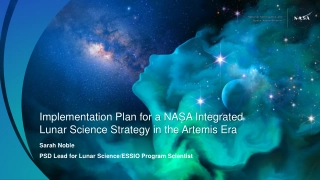
![get⚡[PDF]❤ Building Habitats on the Moon: Engineering Approaches to Lunar Settle](/thumb/21624/get-pdf-building-habitats-on-the-moon-engineering-approaches-to-lunar-settle.jpg)
